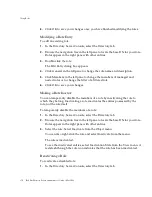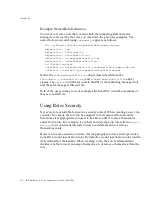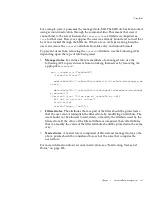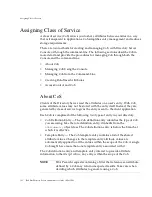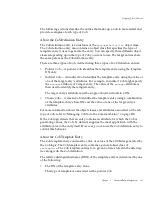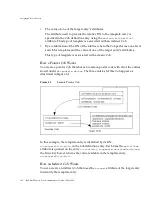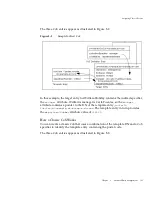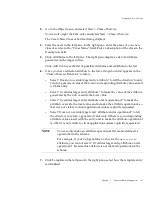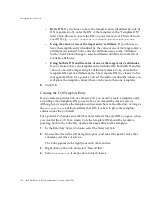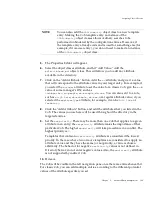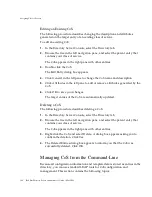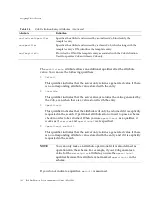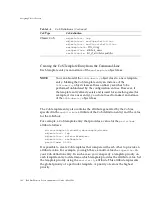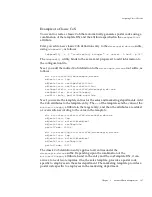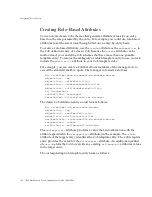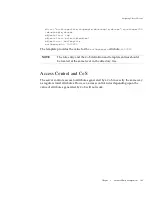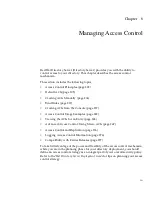
Assigning Class of Service
Chapter 5
Advanced Entry Management
189
5.
The Properties Editor will appear.
6.
Select the object classes attribute, and hit "Add Value." Add the
extensibleobject
object class. This will allow you to add any attribute
available in the directory.
7.
Click on the "Add Attribute" button. Add the
cn
attribute, and give it a value
that will correspond to the attribute value in your target entry. For example, if
you select the
manager
attribute to set the value for a classic CoS, give the
cn
a
value of some manager’s DN, such as
uid=bparker,ou=people,dc=example,dc=com
. You can also set it to a role,
such as
cn=QA Role,dc=example,dc=com
, or a regular attribute value; if you
selected the
employeetype
attribute, for example, it can be
full time
or
temporary
.
8.
Click the "Add Attribute" button, and add the attributes that you listed in the
CoS. The values you use here will be used throughout the directory in the
targeted entries.
9.
Set the
cospriority
. There may be more than one CoS that applies to a given
attribute in an entry; the
cospriority
attribute ranks the importance of that
particular CoS. The higher
cospriority
will take precedence in a conflict. The
highest priority is
0
.
Templates that contain no
cosPriority
attribute are considered the lowest
priority. In the case where two or more templates are considered to supply an
attribute value and they have the same (or no) priority, a value is chosen
arbitrarily. The behavior for negative
cosPriority
values is not defined in
Directory Server; do not enter negative values. Also, the
cosPriority
attribute
is not supported by indirect CoS.
10.
Hit save.
The CoS will be visible in the left navigation pane once there are entries beneath it.
For classic CoS, you can add multiple entries, according to the different potential
values of the attribute specifier you set.
NOTE
You can also add the
LDAPsubentry
object class to a new template
entry. Making the CoS template entry an instance of the
LDAPsubentry
object classes allows ordinary searches to be
performed unhindered by the configuration entries. However, if
the template entry already exists and is used for something else (for
example, if it is a user entry), you do not need to make it an instance
of the
LDAPsubentry
object class.
Summary of Contents for DIRECTORY SERVER 7.1
Page 1: ...Administrator s Guide Red Hat Directory Server Version7 1 May 2005 Updated February 2009 ...
Page 20: ...20 Red Hat Directory Server Administrator s Guide May 2005 Glossary 619 Index 635 ...
Page 22: ...22 Red Hat Directory Server Administrator s Guide May 2005 ...
Page 26: ...26 Red Hat Directory Server Administrator s Guide May 2005 ...
Page 78: ...Maintaining Referential Integrity 78 Red Hat Directory Server Administrator s Guide May 2005 ...
Page 200: ...Assigning Class of Service 200 Red Hat Directory Server Administrator s Guide May 2005 ...
Page 488: ...488 Red Hat Directory Server Administrator s Guide May 2005 ...
Page 528: ...PTA Plug in Syntax Examples 528 Red Hat Directory Server Administrator s Guide May 2005 ...
Page 572: ...572 Red Hat Directory Server Administrator s Guide May 2005 ...
Page 612: ...Examples of LDAP URLs 612 Red Hat Directory Server Administrator s Guide May 2005 ...
Page 634: ...634 Red Hat Directory Server Administrator s Guide May 2005 ...


